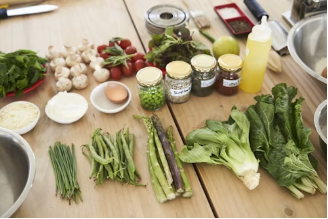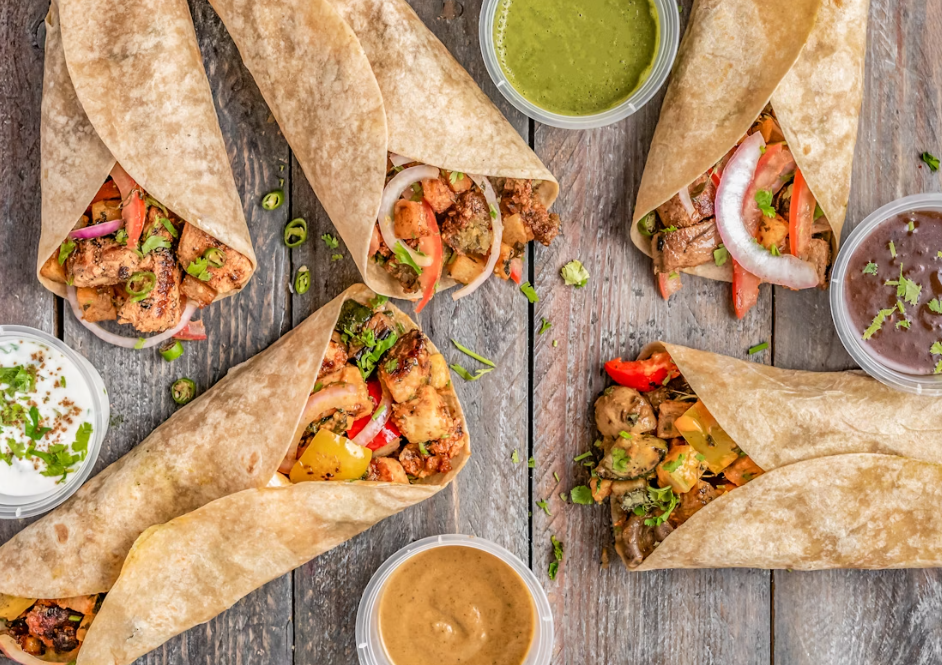October 6, 2025• byleahk
Intuitive eating and meal prepping in the same sentence? These terms can seem contradictory since prepping meals can be limiting if you’re trying to honor your cravings. However, preparing a handful of ingredients to later combine into tasty meals can be a helpful solution for some.
Before we dive in, let’s go over the terms “intuitive eating” and “meal prep.”

What is intuitive eating?
Intuitive eating is a strategy of eating that focuses on tuning into your body’s hunger and fullness cues instead of outsourcing to diet rules.
When eating intuitively, it’s important to allow yourself to eat foods that will satisfy your craving at that moment. This could look like a filling meal with carbs, proteins, fats, and fiber, or a snack that satisfies a particular craving.
What is meal prepping?
Meal prepping is a way to help your future self eat satisfying meals even when you have places to be. People often spend time cooking a few meals that they portion into to-go containers to have on hand for each day of the week. This can be a great way to have convenient meals ready in your fridge that you can take to work, class, or just have already made for times when you don’t feel like cooking.
An Intuitive Approach to Meal Prepping
What if the meals you prepped no longer feel appetizing when it comes time to eat them?
A way to combine the idea of your own pre-made meals while also having freedom to craft up dishes that satisfy your mood is to prepare components that can be easily combined into meals. It’s like leaving the puzzle pieces laid out for when you’re ready to build the puzzle.
What to Prepare
From a gentle nutrition approach, having a variety of carbs, fats, and proteins ready can help make balanced meals that will keep you full and energized throughout the day. Here are some examples of foods to make/have on hand as meal building blocks.
Carbs/fiber:
Carbs are needed to provide quick sources of energy…some ideas could be
- Cooked grains such as rice, quinoa, and farro
- Pasta
- Bread, tortillas, and crackers
- Granola/oats
- Roasted diced potatoes (I love sweet potatoes tossed in a drizzle of olive oil, salt, pepper, garlic powder, and a sprinkle of cinnamon)
- Roasted veggies like peppers, onions, tomatoes, and zucchini or squash
Proteins:
Protein is essential for various physiological functions and its also a key to add staying power to meals. Easy protein sources could be:
- Cooked chicken breasts
- Meatballs (frozen or homemade)
- Cooked ground meat like turkey, chicken, beef
- Tofu
- Falafel
- Canned beans
- Tuna or chicken salad
- Lunch meat
- Boiled eggs
- Yogurt
- Cottage cheese
Fats:
Fats provide energy, absorb nutrients, and help add satisfaction and flavor to meals. Ideas for fat sources are:
- Hummus
- Avocado
- Creamy or oily dressings/sauces
- Nuts
- Peanut butter
- Cheeses
How to use your ingredients:
So you’ve bought meal components and cooked ingredients to use later on, but now what? Here are some examples of ways you can reuse the same ingredients differently.
Sweet potatoes:

- Add roasted sweet potatoes into salads or bowls for a sweet carb source
- Top a baked sweet potato with Greek yogurt, berries, and honey for a carb and protein packed breakfast
- Pair a baked sweet potato with a protein source for a quick dinner or lunch idea
Canned beans:
- Combine black beans and rice to make dirty rice, and add ground protein like beef, chicken, or turkey for extra protein and flavor. Top with salsa or guac, use tortilla chips to add a crunch.
- Blend canned chickpeas with olive oil, lemon juice, garlic, Tahini and spices to make a creamy homemade hummus
- Roast chickpeas with olive oil and seasoning to make crispy chickpeas that are a great salad topper or crunchy snack
- Use black beans or refried beans to make bean burritos along with cheese, and veggies if you like. Or, make it a breakfast burrito by adding scrambled eggs!
Tortillas:

- Make wraps for any meal using tortillas as the base
- Cut tortillas into triangles and bake/fry to make tortilla chips. These can be paired with guacamole or salsa for a snack, eaten with a salad or rice bowl for added carbs, and more
- Make a peanut butter banana tortilla roll up for a satisfying and filling snack
Old Vegetables:
You don’t want to let those old veggies go to waste, but how do you use them when they’re past their prime?

- Freeze for later if they’re starting to go bad
- Sauté with oil and save to make veggie egg scrambles, salad toppers, stir-fry, or mix with quinoa for a veggie protein/carb source
- Roast veggies like onions, tomatoes, peppers, garlic and more and blend into a sauce to make a pasta dish
Try it for Yourself!
Keep your meals interesting by changing what varieties of ingredients you buy; get tortillas one week and a loaf of bread the next, or spinach one week and romaine the next. Play around in your kitchen and discover what puzzle pieces you can prepare ahead of time to conveniently and intuitively make satisfying meals that encourage excitement around cooking.
Thanks to my intern Ande for writing this awesome piece!
Last modified: October 6, 2025











